How to rebuild a Dinosaur
Posted on 25 July 2013
How to rebuild a Dinosaur
 By Stephan Lautenschlager, Fellow and PhD Candidate at the University of Bristol.
By Stephan Lautenschlager, Fellow and PhD Candidate at the University of Bristol.
This article is part of our series: a day in the software life, in which we will be asking researchers from all disciplines to discuss the tools that make their research possible.
Palaeontology, the study of fossils and extinct organisms and modern software technology are two disciplines which seem to have little in common at first glance. However, films and TV documentaries like Jurassic Park or Walking With Dinosaurs not only show this assumption to be wrong, but have also in part stimulated the application of computational methods in palaeontological research.
Facilitated by the introduction of tomographic methods, three-dimensional imaging techniques and computer modelling, the modern palaeontologist has access to a digital arsenal of software tools for the study of fossils. In the last decades, computer technology adopted or designed for palaeontological purposes has constantly evolved, resulting in a huge diversity of software for different fields of research. As such, it is not unusual that up to ten (sometimes even more) different software programs are necessary to address a specific research question. Yet what is necessary to reconstruct the anatomy and possibly the behaviour of that classic poster child of palaeontology - a dinosaur?
Turning bones into bytes
The reconstruction of a dinosaur starts with a specific fossil, preferably one which is nearly complete and shows the majority of its anatomy. As it only exists in the physical realm, so to speak, the fossil needs to be digitised to serve as a basis for further computational steps and analysis. Tomographic applications such as CT scanning or synchrotron radiation X-ray tomographic microscopy (SRXTM) have become the de facto standard and method of choice for the digitisation of fossils in the last decade.
These applications are not only non-destructive (meaning no harm will come to the precious fossil), but can also be used to gain detailed information about the internal structure of the scanned object (similar to a classical medical X-ray image). Since the individual tomographic images are stored in a commonly used image format (BMP, TIFF, DICOM), they can be viewed with most standard image viewers.
For the creation of three-dimensional models, or the visualisation of specific structures within the fossil, a special software capable of assembling these individual CT images is necessary. Different programmes are available, both commercial (Amira, Avizo, Mimics, 3D Studio Max) and open source (Drishti, SPIERS). Using one of these programmes, the fossil and individual structures such as individual bones or the brain and inner ear morphology can be isolated or highlighted. This is a process called segmenting or labelling.
Digital preparation and restoration
Given that fossils generally show a variable degree of fragmentation or deformation resulting from the fossilisation process, it might be necessary to reconstruct the digital model to restore the original morphology of the extinct organisms as accurately as possible. In many cases, this can be done either directly in the CT segmentation software or separately in special 3D modelling and animation programmes (Maya, Blender).
Once the morphology of the skeleton has been restored, different soft-tissue structures can be reconstructed. Of particular interest here is the musculature, which not only defines the anatomical proportions necessary for life reconstruction of the dinosaur, but also serve as input parameters (muscle forces, bite forces, etc.) for biomechanical models and further computational analysis. Modelling the muscles can either be done with the aforementioned software or with special programmes (SIMM), which simulate muscle contractions and joint forces for motion analysis.
Functional analysis
Using the restored skeletal morphology (such as the skull) and the reconstructed soft-tissues (like the jaw and neck muscles), the functional capabilities of the Dinosaur can be tested. Finite Element Analysis (FEA) and Multibody Dynamic Analysis (MDA), two techniques originally developed for applications in the engineering industries, can be used for that purpose. FEA calculates stress and strain in an object in response to loaded forces, whereas MDA computes the dynamic behaviour of complex, connected systems such as a vertebrate skull to predict joint forces and muscle activity.
For this, a number of software tools are necessary to convert the digital model of the dinosaur into and FEA- or MDA-model. FEA calculates stress and strain by dividing the geometry into numerous simple and discrete elements (the so-called FE mesh). Hence the digital model has to be meshed first, before input parameters can be defined and finally the FE model can be solved. Each of these steps requires different software tools (e. g., VoxFE or Hypermesh for mesh generation, Abaqus FEA or Strand7 for solving and analysis), which usually require a large amount of skill, time and dedication from the user.
Combining information into a final model
The information gained from the individual reconstruction processes and functional analyses can then finally be bundled into a detailed model of the dinosaur. Using 3D modelling, imaging and animation software, a Dinosaur model can be assembled, which represents the current state of knowledge and allows us to reconstruct an animal which has been extinct for more than 65 million years.

